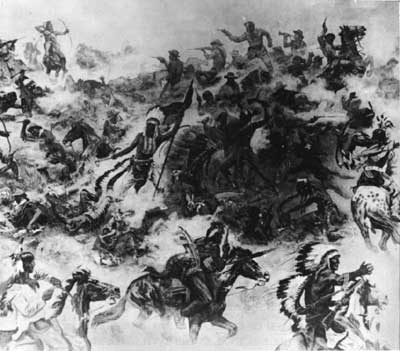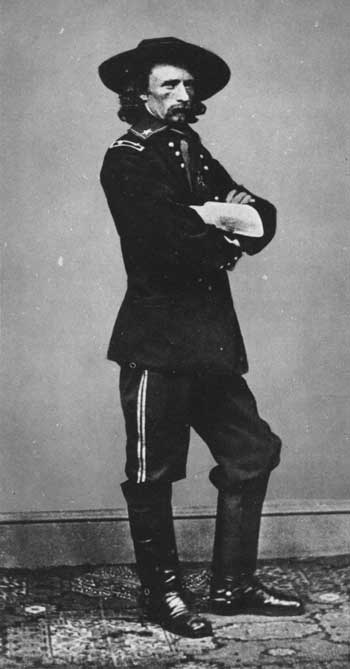|
LITTLE BIGHORN BATTLEFIELD National Monument |
 |

"General Custer's Last Battle," painted by Elk
Eber. The original is on exhibition in the Karl May Museum, Dresden,
Germany. This painting is fairly accurate in details. The absence of
sabers or swords agrees with factual data. The soldiers were equipped
with Springfield carbines and Colt or Remington revolvers; and perhaps
one-third of the Indian warriors used firearms.
THE BATTLE of the Little Bighorn River, on June 25—26, 1876, was one of the last important instances of violent resistance by the American Indians to the advance of white settlement. This fight was the principal one in the war whereby the Northern Cheyenne and several tribes of Sioux, described as hostile, were subdued.
The battle consisted of two entirely separate actions. The first, in the valley, was fought under the leadership of Major Reno, whose troops retreated before an overwhelming number of Indians and took refuge on the bluffs across the river where, joined by Captain Benteen's force, they defended themselves until the foe withdrew. In the other action fought nearly 5 miles away, in the vicinity of what is now the monument headquarters, five troops of the Seventh Cavalry under Custer's personal command were overwhelmed by the savage fury of the attacking horde. This was "Custer's Last Battle."

Maj. Gen. George A. Custer about 1865. The wide hat, sailor's
shirt, and red cravat were of his own design.
(Photograph by Brady.)
Causes of Warfare
The continued expansion of the white men west of the Mississippi River forced the Plains Indians on restricted reservations. Good grazing and hunting lands had been allotted to them, only to be taken away when avaricious white settlers and fortune hunters demanded the land for other uses.
The treaty of 1868, signed at Fort Laramie, Wyo., provided that a large area be set aside as a permanent home for Sioux and Cheyenne Indians. This area, known as the Great Sioux Reservation, included the Black Hills, which were abundant with game, and was for the exclusive use of the Indians. The treaty also specified that the Indians retain certain hunting privileges within defined limits outside the reservation.
In 1874 General Custer and the Seventh Cavalry were sent from Fort Lincoln, in Dakota Territory, with a scientific expedition into the Black Hills, principally to explore the area and to secure military information. While exploring the country, rumors of gold in the hills were confirmed by prospectors who accompanied the military force.
The immediate effect of the circulation of news of the gold discovery by Custer's Black Hills expedition was the invasion of the region by hordes of miners. Since the hills lay within the Great Sioux Reservation the Federal Government was bound by treaty stipulation to prevent the migration of its citizens to the area. Because of actual and potential values of the Black Hills to the Indians, would-be intruders could expect anything but gentle treatment. The magnetic attraction of gold, however, was too powerful for either fears of physical dangers or personal hardships to counteract. Nor did respect for the sanctity of treaty obligations serve as an effective deterrent. Hence, the white adventurers were ready to brave the hardships of a Dakota winter in an isolated wilderness infested by semihostile Indians and possible military eviction.
From the viewpoint of the whites, the conflict was caused by the hostility of certain Indians who made raids on the white settlements and refused to reside on the reservations. From the Indian point of view, the conflict was due to the repeated encroachment upon their lands by frontiersmen, often in violation of treaty stipulations. The rations issued the Indians at the reservations did not always seem sufficient to meet their wants, and they were angered particularly by the invasion of their reservations by gold seekers who, in defiance of Government orders and despite the eviction of some of their numbers by the military, persisted in going into the Black Hills.


|
|
Last Modified: Sat, Sep 28 2002 10:00:00 pm PDT |


